While conducting a student focus group recently, I was struck by the teens’ enthusiasm for the print booklets — a.k.a. “college mail” — spread on the table before them. We asked them to look at a range of materials including viewbooks, travel pieces, and other assorted recruitment materials. The students in our groups really seemed to enjoy paging through the pieces.
As marketers, we were trying to understand how and why each piece appealed to prospective students. Some of them were drawn to the big images, while others liked to see photos of professors interacting with students. Many just scanned the pages.
Here’s what students really think of college mail:
- Images. Students commented on imagery more than anything else. They had a keen sense of staged images and mocked these pictures mercilessly.
- Text. They read big headlines more often than dense paragraphs. In some cases, images were strong enough to stand alone. Many hefted the books back and forth, flipping through the pages as if they were perusing an issue of People in the grocery line. From the speed at which they scanned the pages, it was clear that very little reading was going on.
- Size. It matters. Standard sizes blended in. While you don’t necessarily need to go big, going non-standard will lead to more opens and better mailbox appeal.
- Sense of belonging. Students want to picture themselves on your campus. They were very drawn to pieces with campus maps and reminisced about how they cross-referenced their class schedules with those maps to estimate their class-to-class commute.
Though this anec-data was helpful and directional, we’ll be the first to point out that focus groups are artificial environments in which to gauge user attitudes and behaviors. There’s peer pressure to say the right thing, a competitive instinct to outsmart each other, and even the pressure to say what they think the adults in the room want to hear. That said, on a spectrum that ranges from installing a two-way mirror in their living room to blindly designing with zero feedback, directly asking teens’ opinions is a great start.
Organizing a focus group to review your own materials can feel daunting, but it doesn’t have to be complicated.
- Inviting groups fresh off your campus tour can be a great way to get some quick opinions from both students and parents.
- You may want to consider scheduling your focus groups during or just following orientation so you can speak with students for whom the college search process is still very fresh.
- In the weeks leading up to your focus group, try to gather print materials from other institutions as well as the one you represent. By offering a variety of pieces for their review, you’ll get to hear why students hate your piece, but love the one from the college down the road. Showing a hodgepodge of materials will also simulate the mailbox experience. You’ll hear more and better feedback about which ones stand out, and which ones fade into the pile.
- Consider the kinds of pizza you’ll be ordering. Because you need some kind of incentive to get students to show up. Free food does the trick, and it will help you reach students who aren’t typical joiners. If you speak only to those who are excited and outgoing, you’ll get a skewed perspective of what’s really working. Getting opinions from all types of students is essential to understanding how to create more persuasive communications .
